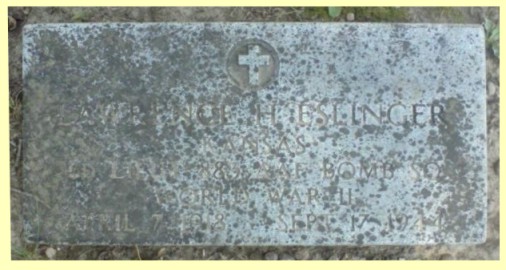
Lawrence Esslinger's tombstone in Manhattan's Sunset Cemetery.
Comments? [email protected].
Earlier columns from 2015 may be found at: 2015 Index.
Links to previous years are on the home page: Home
Kansas Snapshots by Gloria Freeland - June 12, 2015
Just a Sunday evening in September
Sept. 17, 1944 was a typical fall Sunday for the 250 inhabitants of Copeland, Kansas. In the small village 40 miles southwest of Dodge City, the afternoon temperature had reached the mid-80s, but by evening, it had cooled to a comfortable 70. The gusty wind settled to a fairly steady 20 mph from the south.
On their farm a mile south of the village, 59-year-old Ora Hiram Hatfield and his wife Kittie were in the dining room as night set in. Their daughter Ruth Settles was with them while their almost 1-year-old grandson Jay Settles slept upstairs. Ruth and Jay were living with her parents while her husband Dean completed his duties as a B-17 pilot in Europe. Having flown his 25th mission on D-Day, he had earned a trip home and had just recently returned to duty.
Since the June landings in France, the war against Germany had been going well. The Western Allies had largely pushed the German forces out of France, Belgium and the Netherlands while the Russians were squeezing them westward. With this turn of events, America's attention began to focus more sharply on its efforts against Japan. The B-17 and B-24 bombers had been effective in Europe, but the distances in the Pacific required a plane with a greater range. That plane, the B-29, began to hit its production stride in the spring of 1944. Crews were needed to fly them and Walker Air Force Base, 10 miles east of Hays, Kansas, had been built to train them.
On that September evening, a crew led by 2nd Lieutenant Wayne B. Cooper of Shelby, Tennessee and his native-Kansas co-pilot 2nd Lieutenant Lawrence H. Eslinger were scheduled to make a routine training flight. They were to practice air-to-ground gunnery, but shortly after takeoff, the bombardier became ill and the plane returned to Walker to drop him off. Since it was now turning dark, their orders were changed to practicing night instrument flying.
But the quickly-constructed and only partially-outfitted Walker field did not have the full complement of navigation equipment. So Walker crews routinely sought permission to use other fields in the area that were fully equipped.
War is a deadly business. So for the mostly under-25 men flying those planes, escape from that reality was constantly being sought. This need was made more acute by hours of tedious drill. The aborted gunnery mission and the obvious fill-in assignment was an opportunity. Buzzing - flying low - over the home of someone known by a crew member - was a common such activity. Being strictly against policy, it was best done when the likelihood of getting caught was low, that is, at night in a rural area.
Eslinger, whose parents Harold and Esther now lived in Manhattan, Kansas, had been born and raised near Kinsley, just east of Dodge City. Their next-door neighbors were the family of Charley Hatfield, a brother of Ora Hatfield. At some point prior to entering the service, Eslinger had apparently worked on the Ora Hatfield farm, probably referred by Charley. So on the night of Sept. 17, the Cooper crew decided they would buzz the Ora Hatfield farm. At a B-29's cruising speed, it was less than an hour away from Walker.
A B-29's four 2,000-horsepower engines make a lot of noise. Several people in the Copeland community remarked that evening about hearing the low-flying plane.
But on a slow right turn that would take them over the farmhouse, a wing struck the ground. It is believed the plane cartwheeled and the several thousand gallons of aviation gasoline aboard began burning.
Why was the Cooper airplane too close to the ground? Perhaps crew members were distracted by their intended prank and were slightly disoriented by the dark. Or maybe they were relying on their instruments, but had failed to correct their altimeter to allow for the fact that Copeland is almost 900 feet higher in elevation than Walker. They would have then believed they were approximately 1,000 feet above the ground.
Almost all of the buildings on the farm were incinerated. Every member of the plane's crew died. Hatfield and his grandson also died. Somehow, Kittie and Ruth escaped. It was reported that they were found on the nearby road by a passing motorist who took them for treatment.
For those of us now well-removed from those war years, when we hear of someone who was lost in service, an image of armed conflict automatically comes to mind. Yet, for every serviceman lost in World War II due to enemy action, another was lost due to disease or mishap such as the one on the Hatfield farm. Harold and Esther Eslinger lost a son. So did the parents of the other boys on that B-29. Not one of them ever saw combat, yet their deaths would have been felt as keenly - possibly more so - as if they had.
As for Kittie and her daughter, both recovered from their burns. Dean returned from service and he and Ruth had two more children. They worked in the school systems of Alaska for many years before retiring to Colorado.
(Information for this piece was gathered from newspaper accounts, a published diary, a book about B-17 pilots, and various public records.)

Lawrence Esslinger's tombstone in Manhattan's Sunset Cemetery.
Comments? [email protected].
Earlier columns from 2015 may be found at: 2015 Index.
Links to previous years are on the home page: Home